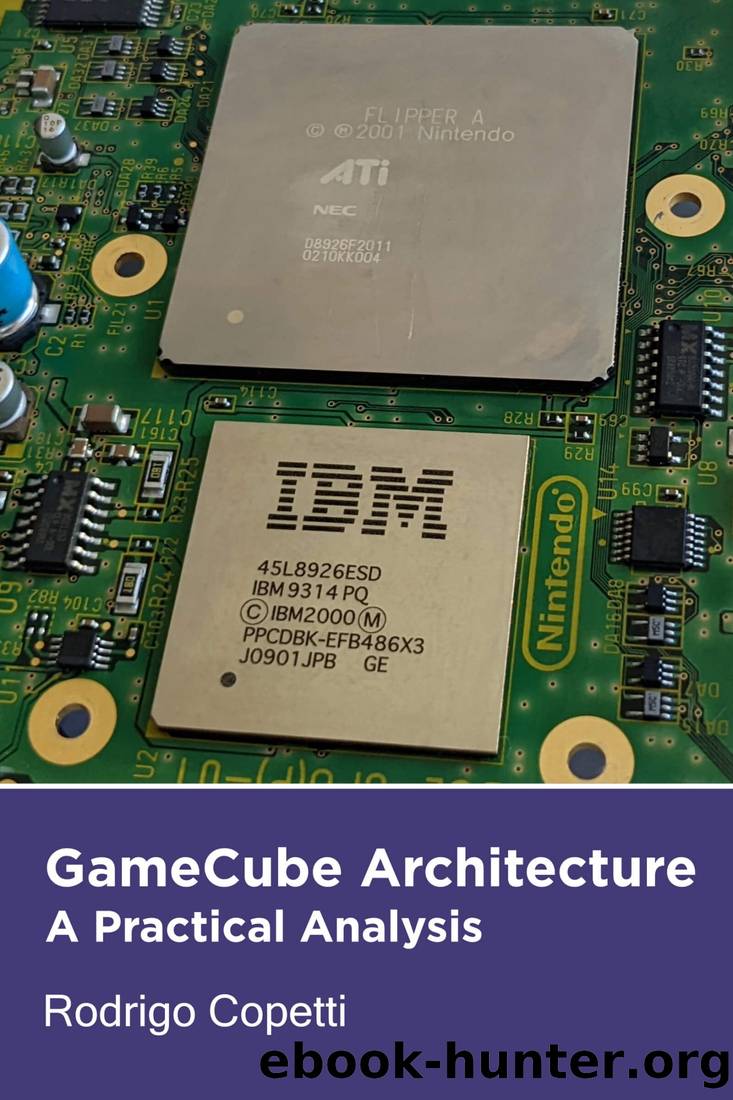GameCube Architecture: Powerful and Compact by Rodrigo Copetti

Author:Rodrigo Copetti [Copetti, Rodrigo]
Language: eng
Format: epub
Tags: Nonfiction, Computers, Advanced Computing, Engineering, Computer Architecture, Application Software, Computer Graphics, Computer Science
ISBN: 9798201660857
Amazon: B0B6G9Z4BC
Goodreads: 62908910
Published: 2019-11-18T14:30:00+00:00
6 Audio
Nintendo finally delivered some dedicated audio circuitry to offload the huge task from the CPU-GPU and provide richer sounds. Their new solution is an independent Digital Signal Processor or âDSPâ manufactured by Macronix running inside Flipper.
The DSPâs job consists of performing different operations over our raw audio data (e.g. volume changes, sample rate conversion, 3D sound effects, filtering, echo, reverb, etc) and then output a 2-channel PCM signal. It doesnât work alone however, the DSP delivers audio with the help of other components.
Its first companion is the Audio Interface (AI), a 16-bit stereo digital-to-analogue converter responsible for sending the final sample through the audio signal that ends on the TV. The AI can only process 32 bytes of audio data every 0.25ms, so if we take into account that each sound sample weights 2 bytes and we need two to create stereo sound, the AI will be able to mix up to eight stereo samples with up to 32 kHz of sampling rate, sound!
Finally, we have the Audio RAM (ARAM) block, which is a large (16 MB) but very slow spare memory that can be used to store raw sound data. Thereâs quite a lot of space, so the GPU can also use it to store additional material (like textures). The CPU doesnât have direct access to this memory so it will resort to DMA to move content around.
For better or worse, the DSP is programmable with the use of microcode (yikes), but fear not, as the official SDK already bundles a general-purpose microcode that almost every game used, except on the consoleâs boot sequence and some Nintendo games (how convenient, as Nintendo didnât document the DSP, so only they know how to program it).
That being said, the process of generating sound works as follows [11]:
CPU commands DMA to move raw samples to ARAM.
CPU sends a list of commands that instruct how the DSP should operate these samples. In other words, it uploads the microcode program (only one is officially available for developers).
DSP fetches samples from ARAM, applies the required operations and mixes them into two channels. Finally, it stores the resulting data on RAM.
AI fetches processed samples from RAM and outputs them through the audio signal.
Download
This site does not store any files on its server. We only index and link to content provided by other sites. Please contact the content providers to delete copyright contents if any and email us, we'll remove relevant links or contents immediately.
| AI & Machine Learning | Bioinformatics |
| Computer Simulation | Cybernetics |
| Human-Computer Interaction | Information Theory |
| Robotics | Systems Analysis & Design |
Algorithms of the Intelligent Web by Haralambos Marmanis;Dmitry Babenko(16232)
Jquery UI in Action : Master the concepts Of Jquery UI: A Step By Step Approach by ANMOL GOYAL(9385)
Test-Driven Development with Java by Alan Mellor(7729)
Data Augmentation with Python by Duc Haba(7605)
Principles of Data Fabric by Sonia Mezzetta(7375)
Learn Blender Simulations the Right Way by Stephen Pearson(7293)
Microservices with Spring Boot 3 and Spring Cloud by Magnus Larsson(7137)
Hadoop in Practice by Alex Holmes(6586)
RPA Solution Architect's Handbook by Sachin Sahgal(6513)
The Infinite Retina by Robert Scoble Irena Cronin(6215)
Big Data Analysis with Python by Ivan Marin(5930)
Life 3.0: Being Human in the Age of Artificial Intelligence by Tegmark Max(5506)
Pretrain Vision and Large Language Models in Python by Emily Webber(4893)
Infrastructure as Code for Beginners by Russ McKendrick(4651)
Functional Programming in JavaScript by Mantyla Dan(4432)
WordPress Plugin Development Cookbook by Yannick Lefebvre(4379)
The Age of Surveillance Capitalism by Shoshana Zuboff(4241)
Embracing Microservices Design by Ovais Mehboob Ahmed Khan Nabil Siddiqui and Timothy Oleson(4146)
Applied Machine Learning for Healthcare and Life Sciences Using AWS by Ujjwal Ratan(4132)
